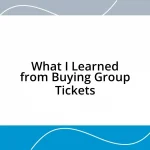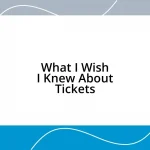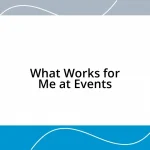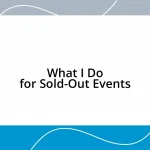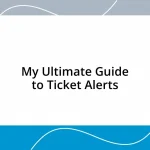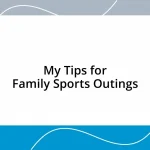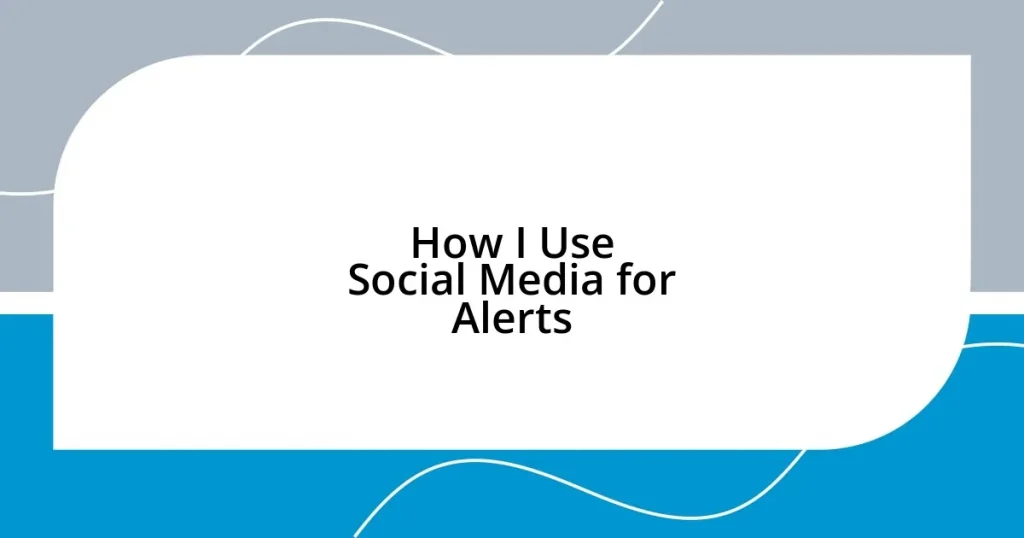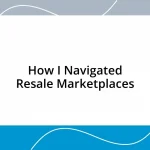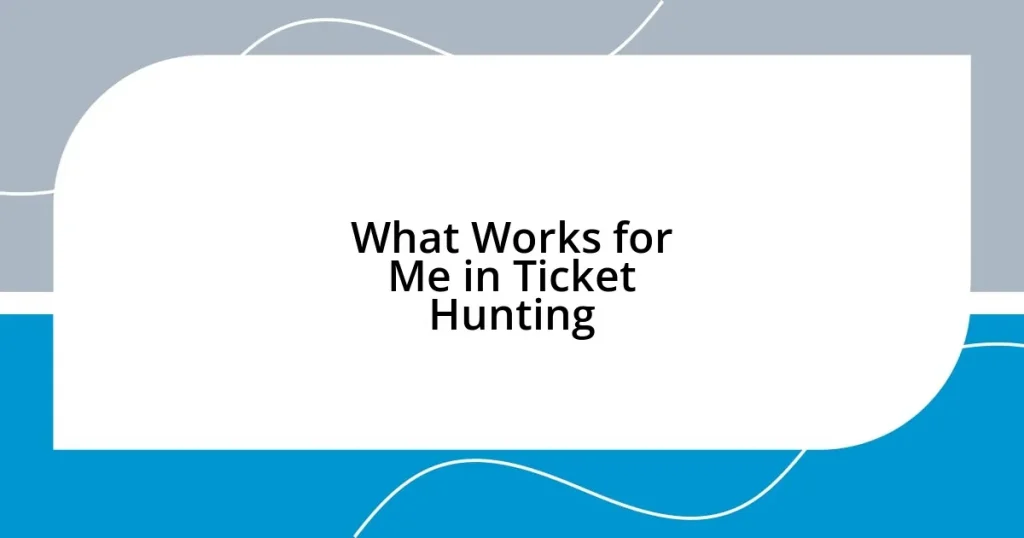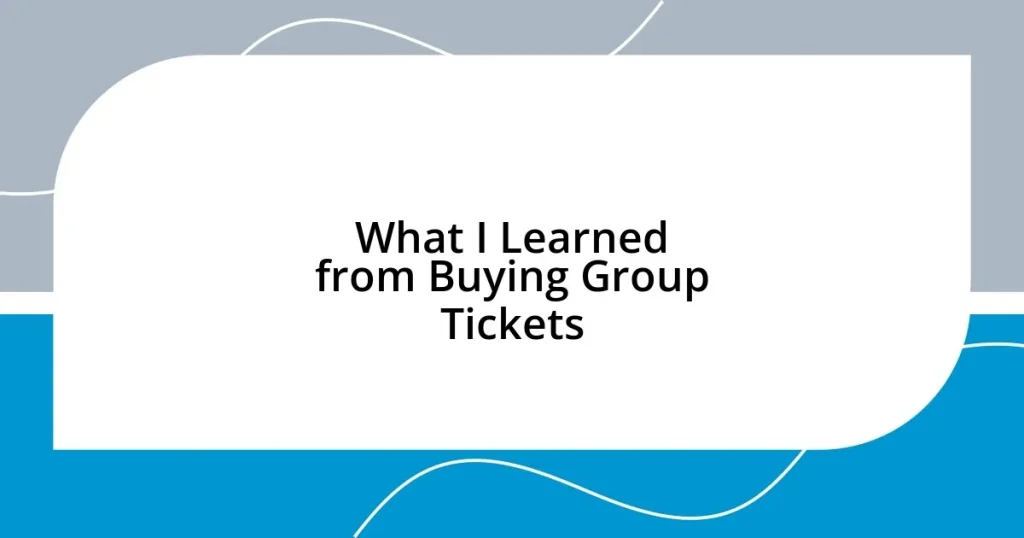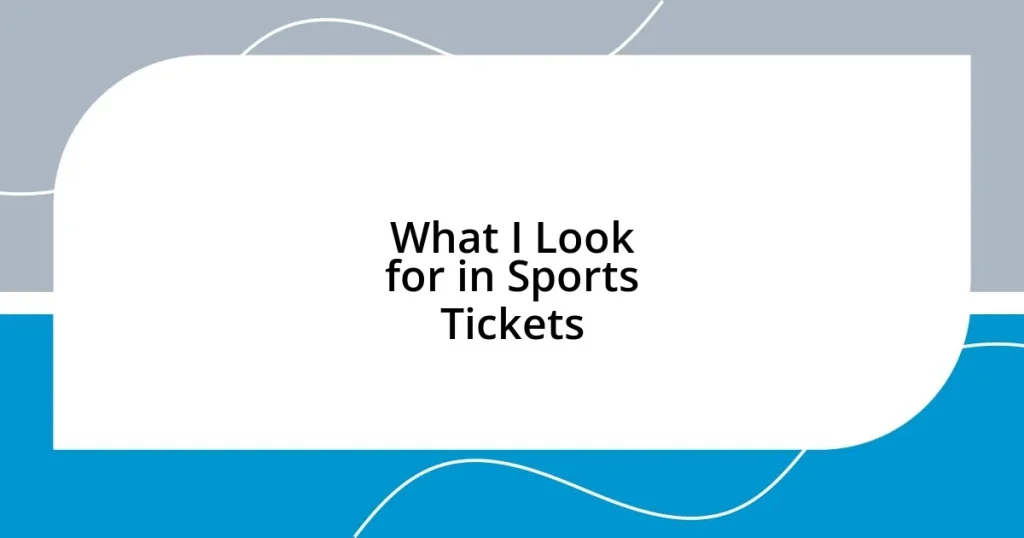Key takeaways:
- Social media alerts provide timely updates, helping users stay informed without sifting through cluttered feeds.
- Choosing the right platforms for alerts (e.g., Twitter for real-time news, Instagram for visual updates) enhances relevance and connection to interests.
- Customizing alert settings, including keywords and delivery methods, personalizes the experience and increases engagement with meaningful content.
- Engaging with alert information through sharing and commenting fosters community involvement and amplifies the impact of the shared alerts.
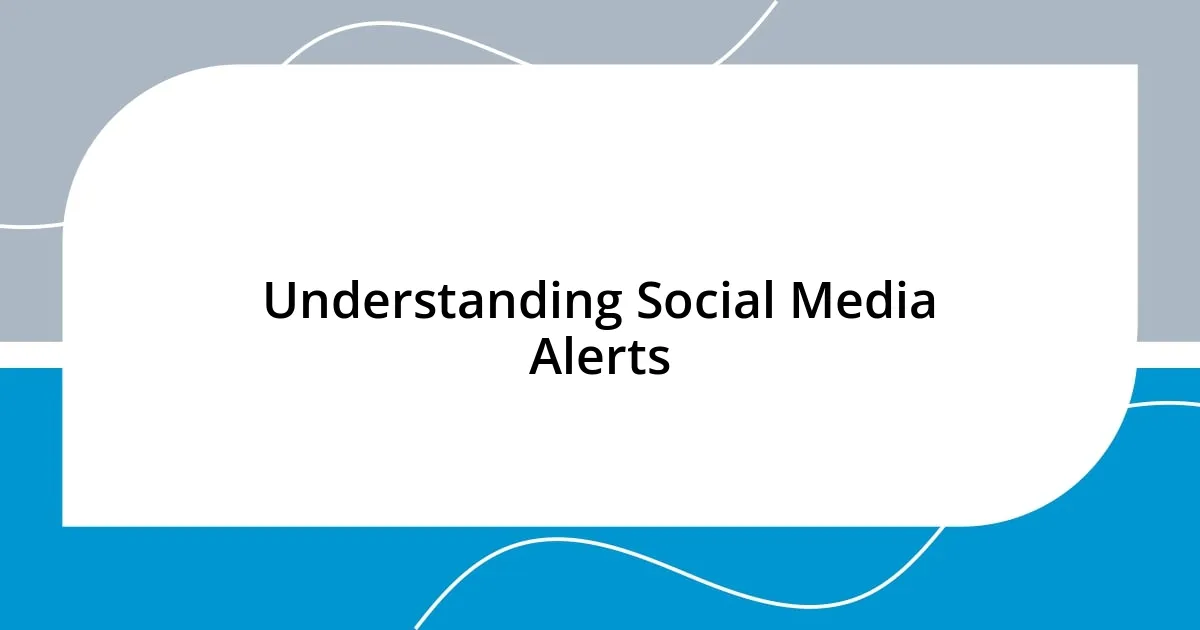
Understanding Social Media Alerts
Social media alerts are like digital beacons, guiding us through the noise of online content. I remember the first time I set up alerts for local news updates; it felt empowering to have the world’s happenings delivered straight to my device. How often do you find yourself missing crucial updates simply because they get lost in the clutter?
Alerts serve a dual purpose: they keep us informed while ensuring that we don’t have to scour through endless feeds. When I first embraced alerts, I was astonished by how quickly I received updates on topics I cared about. Imagine receiving a prompt notification about a natural disaster in your area before the news cycle even picks it up; it’s not just timely, it’s truly life-saving.
Understanding the mechanics behind these alerts is essential for maximizing their benefits. Each platform offers different settings tailored to our unique needs, so customizing alerts is key. Have you explored these options yet? Trust me, taking a few minutes to tweak your settings can lead to a much more streamlined and relevant social media experience.
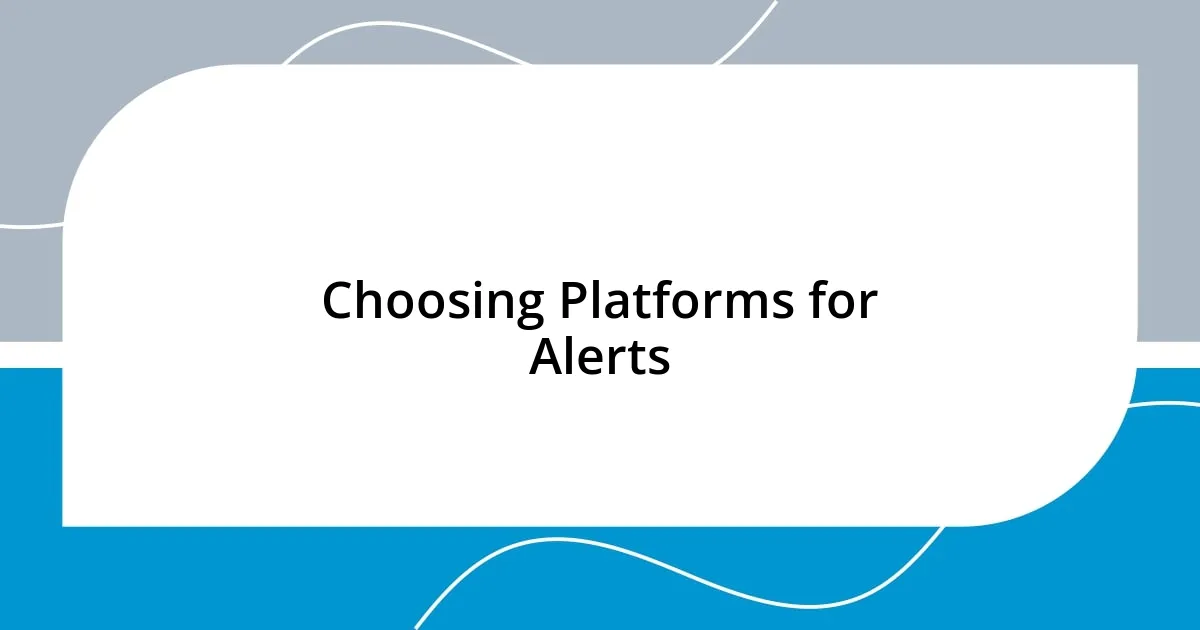
Choosing Platforms for Alerts
Choosing the right platform for alerts really depends on what you want to stay updated about. For instance, I found that Twitter is my go-to for real-time news alerts. The immediacy is unparalleled; when I need to know what’s happening right now, it’s like having a news desk in my pocket. On the other hand, platforms like Facebook allow for a bit more depth, connecting voices and insights on various topics, which can be great if you want context alongside breaking news.
When I first experimented with setting alerts on Instagram, I was pleasantly surprised. It wasn’t just about pretty pictures anymore; I could receive updates from my favorite environmental activists and local artists. The visual aspect helps me feel more connected and informed about community events, which I absolutely cherish. Plus, it’s a great way to keep up with stories that are meaningful to me, blending information with inspiration.
Moreover, I’ve noticed that platforms like Reddit offer a unique way to customize alerts based on niche interests. The ability to subscribe to specific subreddits means I can not only follow breaking news but also engage in discussions around those topics. It’s less about consuming content and more about being part of a community that shares my passions. How does that resonate with your own experiences on these platforms?
| Platform | Strengths |
|---|---|
| Real-time updates, fast-paced news cycle | |
| Deeper engagement, community insights | |
| Visual updates, inspiration from various creators | |
| Community-driven discussions, niche topics |
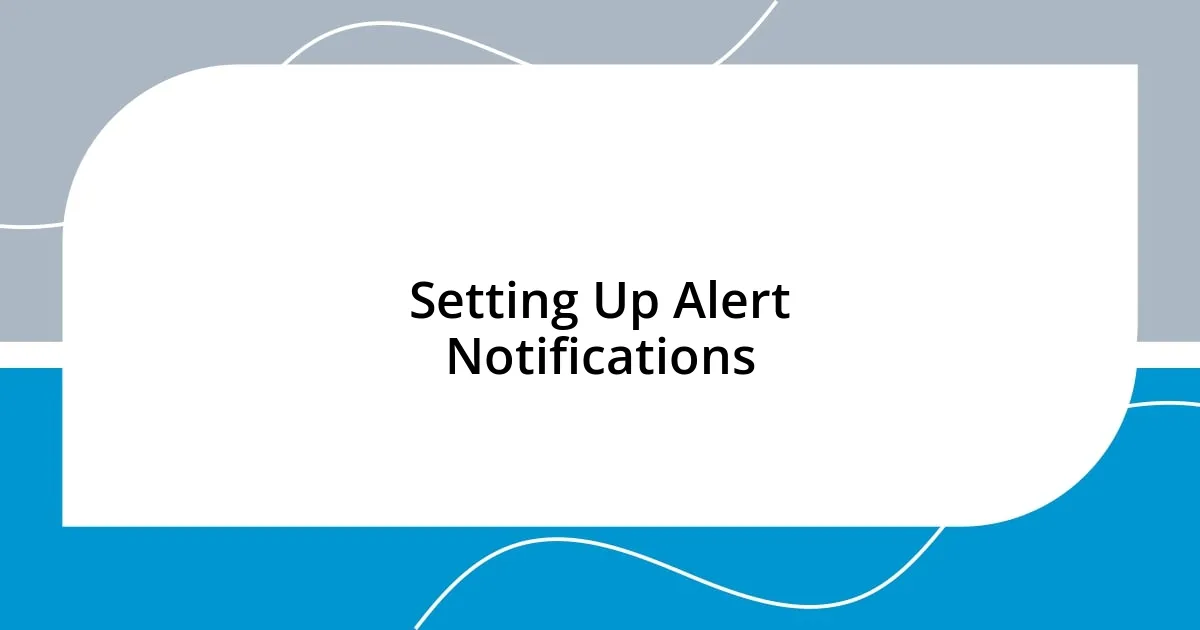
Setting Up Alert Notifications
Setting up alert notifications is a crucial step in ensuring you receive timely updates. I vividly remember the first time I adjusted my settings on Twitter. The moment I enabled alerts for local emergency services, I felt a sense of security wash over me. It was comforting to know I’d receive immediate notifications about anything happening in my area. I quickly learned that customizing my notifications to focus on specific accounts and topics greatly enhanced my experience; it turned a chaotic feed into a streamlined flow of essential information.
To get the most out of your notifications, consider these tips:
- Choose Relevant Sources: Focus on accounts or pages that consistently provide valuable updates for your interests.
- Adjust Frequency: Control how often you receive alerts; daily summaries can be less overwhelming than constant alerts.
- Prioritize Topics: Select topics that are most relevant to you – breaking news, weather updates, or specific events.
- Utilize Keywords: Some platforms allow you to set alerts based on specific keywords. This feature can be life-changing for staying on top of niche interests.
- Review and Revise: Periodically check your alert settings to ensure they still meet your needs; our interests often change.
The process of setting up alerts can feel a bit like assembling a personal news team. I recall feeling giddy when I first set customized alerts on Facebook. I felt like I was creating a tailored news bulletin for myself, gathering the insights of friends, local groups, and trusted sources in one place. Each ping of my phone brought a rush— “Ah, there’s that community event I’ve been wanting to attend!” Being proactive with alert notifications empowers me to engage in my community more fully, making each update feel relevant and exciting.
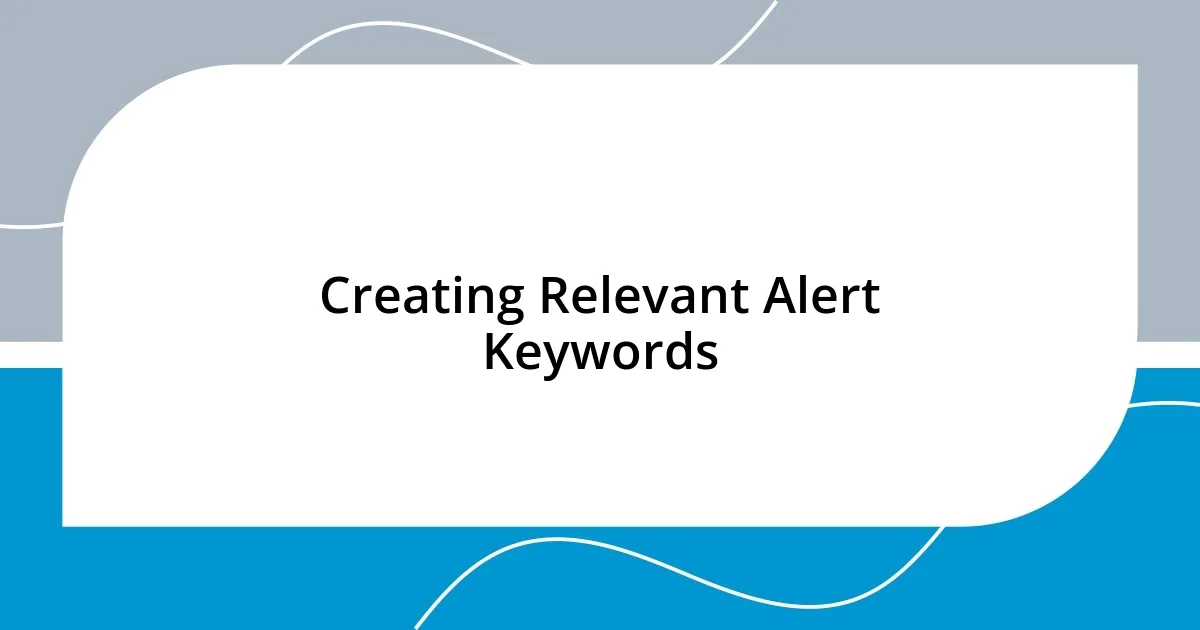
Creating Relevant Alert Keywords
Creating relevant alert keywords can significantly enhance your social media experience. When I began tailoring my alert keywords, it was like stepping into a realm of personalized information. For instance, I started with broad terms related to my interests, but soon found that honing in on specific phrases—like “sustainable living” or “local art shows”—allowed me to receive updates that felt directly relevant to my life and passions.
I still remember the excitement I felt when I first discovered the power of keywords. I typed in unique phrases related to volunteer opportunities in my community, and suddenly my feed was filled with exciting and meaningful local events. Hasn’t anyone else felt that joy that comes with finding something unexpectedly valuable? This level of specificity turned my social media platforms into a vibrant hub of engagement rather than just a space for passive scrolling.
Another useful approach I’ve adopted is grouping keywords thematically. For example, I have a separate set of keywords for environmental alerts, tech news, and community events. It feels like I’ve organized my social media experience into neatly labeled boxes. This strategy not only keeps my alerts structured but also allows me to prioritize different aspects of my life effortlessly. I often ask myself, “Am I in the mood for environmental insights, or am I looking for community news today?” Tailoring my keywords empowers me to make that choice swiftly and enjoyably.
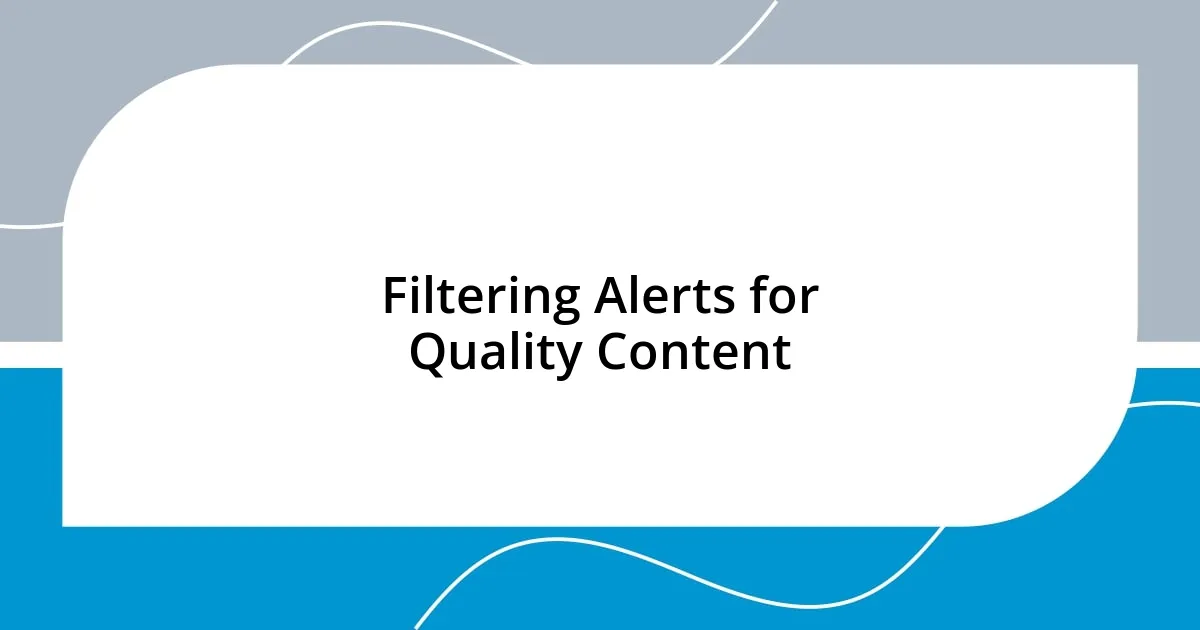
Filtering Alerts for Quality Content
Filtering alerts for quality content has become an art form for me. I recall a time when my notifications felt overwhelming, like a digital tidal wave crashing over me. I decided to narrow my focus to a select group of key sources, and it transformed my online experience. With each curated alert, I felt a renewed sense of connection and relevance; it was like picking out the perfect playlist rather than a jumble of random tracks.
I’ve discovered that employing specific filters can change the game entirely. By categorizing alerts into themes, I often find myself energized rather than drained. I created separate folders for general news, health updates, and community events, akin to sorting my daily life into manageable highlights. Isn’t it fascinating how a little organization can make social media feel both productive and enjoyable?
Additionally, keeping track of what content resonates with me has been incredibly helpful. I remember a week when I strategically reviewed which alerts I’d interacted with the most. It became evident which topics sparked my interest and which ones just cluttered my feed. That process felt almost liberating! Now, as I adjust my filter settings every so often, I’m reminded that my social media should enhance my experience, not complicate it. Isn’t that the essence of quality content?
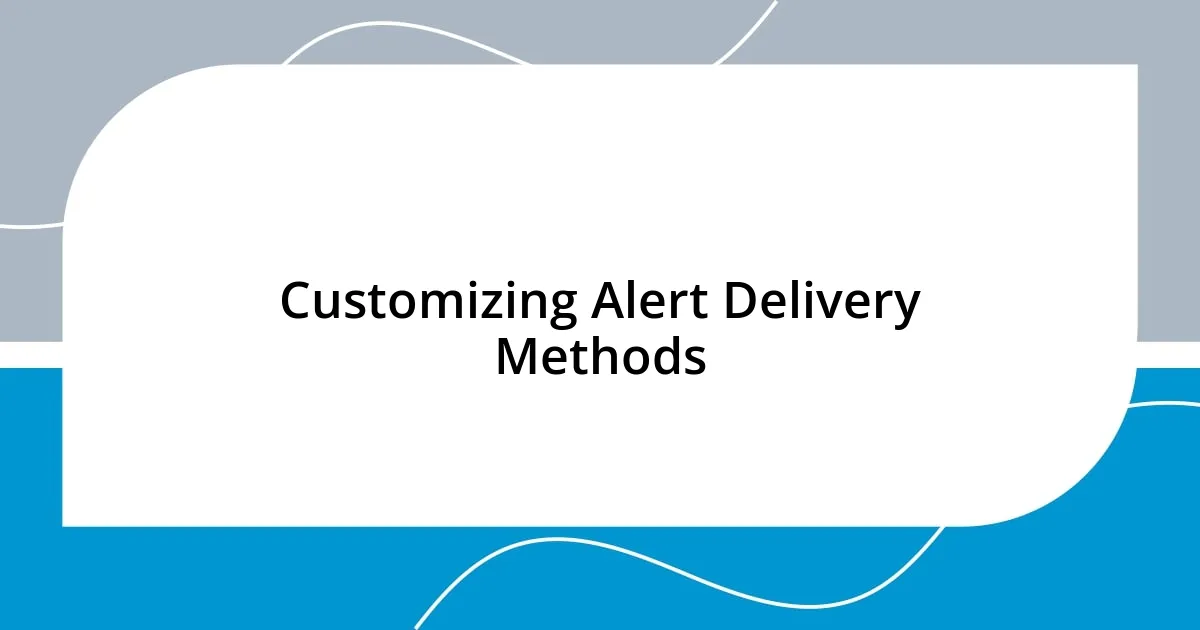
Customizing Alert Delivery Methods
Customizing how I receive alerts on social media has truly been one of my favorite aspects of refining my online experience. I’ve played around with different delivery methods—email notifications, in-app alerts, and even SMS. It took some trial and error, but I found that SMS alerts often feel much more immediate and urgent, especially for events or breaking news. Isn’t it interesting how the method of delivery can shape our engagement with information?
In particular, I remember when I switched to in-app notifications for local events. Initially, I was hesitant; would my phone buzz with constant distractions? Surprisingly, it was the opposite! Those strategically timed pings often came through at just the right moment, reminding me of things I wanted to attend, which helped me feel more connected to my community. Have you ever noticed how a little nudge can push you toward something you’re excited about?
I also like to mix and match my delivery methods depending on the nature of the alert. For instance, I reserve email alerts for more in-depth articles or newsletters, while quick updates come through my app notifications. This tailored approach keeps me organized and engaged, allowing me to focus on what matters most daily. Don’t you think having control over how we receive alerts makes the experience feel much more personal?
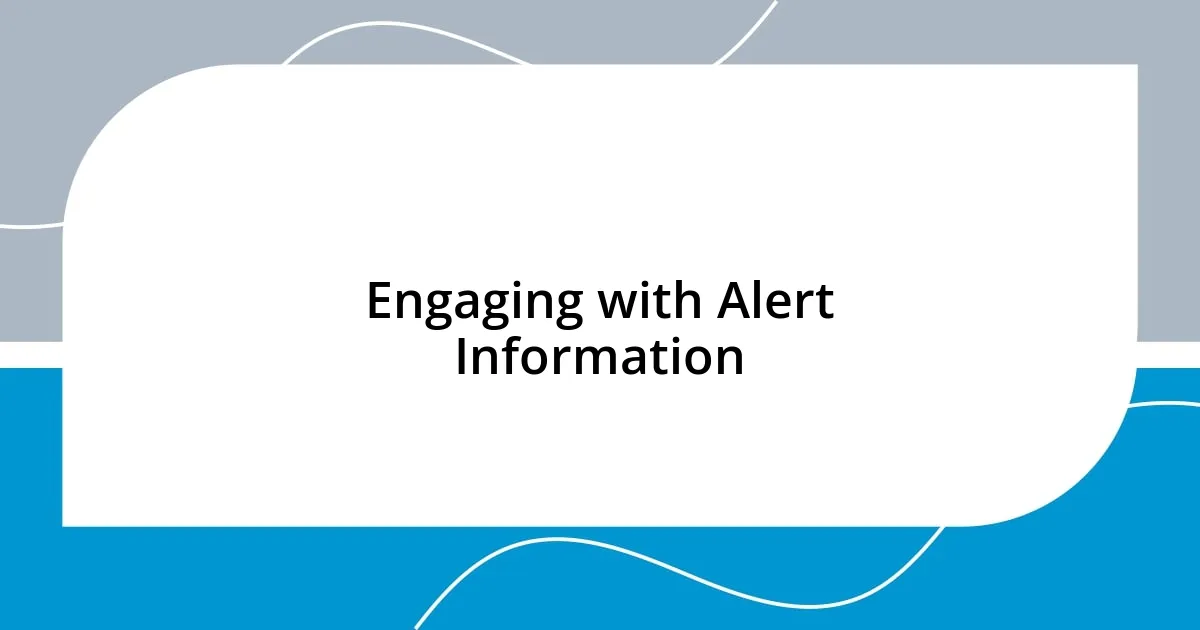
Engaging with Alert Information
Engaging with alert information goes beyond mere consumption; it’s about interaction and contribution. The other day, I stumbled upon an alert regarding a community clean-up event posted by a local organization. I felt a surge of motivation and quickly shared it across my own social media, encouraging friends to join. Isn’t it empowering to turn information into action? That moment reminded me that social media serves as a platform for collective engagement, where an alert can spark an initiative.
I’ve also found immense value in commenting on alert posts. For example, when I saw a safety alert in my neighborhood, I took a moment to share my thoughts and experiences related to the issue. It was enlightening to see others pitch in, sharing their stories and updates. This kind of dialogue creates a sense of community—one where everyone feels they can contribute. How often do we forget that our unique perspectives might just be what someone else needs to hear?
The way I engage with alert information evolves constantly. I’ve started utilizing reactions—like, share, or heart—on specific posts to signify their importance to me. I remember feeling particularly anxious about a local health alert. Instead of just reading through it, I reacted and shared it in a group I belong to, opening the floor for discussion. I realized that actively participating in the conversation not only helps me process the information but also allows others to feel connected and informed. Isn’t it fascinating how our interactions can amplify alert information’s impact?


